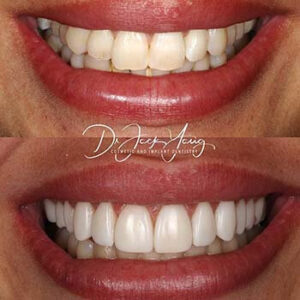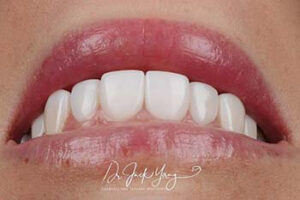Are you wondering how to fix discoloured teeth? You’re certainly not alone. Stained or yellow teeth can make you think twice about smiling and perhaps you even hide your smile behind your hand. Fortunately, there are several cosmetic dental treatments that can fix tooth discolouration and one of them is dental veneers, but first of all, let’s take a look at the two types of tooth discolouration and the differences between them.
Extrinsic and intrinsic tooth stains
Extrinsic staining refers to external surface discolouration that typically spreads out over a tooth’s entirety, making it appear yellow in colour. Usually, this is a result of consuming highly pigmented food and drinks such as curries, spaghetti bolognese, coffee and black tea. Other causes of extrinsic tooth discolouration include red wine and smoking.
 Intrinsic staining on the other hand is usually more localised and appears in small and very dark patches. These type of stains are deeply ingrained in the teeth and can appear due to:
Intrinsic staining on the other hand is usually more localised and appears in small and very dark patches. These type of stains are deeply ingrained in the teeth and can appear due to:
- Disease
- The layer of dentin showing through when the tooth enamel thins (usually with age)
- A side effect of medications
- Overexposure to fluoride.
If your teeth are discoloured and you have stains like these there are several ways to clean or cover them.
Generally speaking, extrinsic stains are easier to deal with than intrinsic stains and it’s the latter that usually have to be hidden by cosmetic means such as dental veneers.
How to fix discoloured teeth caused by extrinsic stains?
The good news is that extrinsic staining is an easy fix. Our team at Beyond Infinity Dental, for example, provide the latest and proven in-office and take-home whitening kits using Zoom and Pola respectively.
Philips Zoom can whiten teeth by up to 6 shades and treatment is typically be completed within a one-hour appointment. Perfect if you’ve got a special occasion such as a job interview and you want your smile to look its best. For patients who want to get rid of tooth discolouration more slowly, we provide Pola custom whitening trays to be used in the convenience of their home. Typically it may take up to 14 days of use to achieve similar results.
Whitening intrinsic staining
Intrinsic staining usually doesn’t respond well to teeth whitening treatments and instead, the affected teeth will need to be covered up. This can be accomplished with dental veneers or crowns. Unfortunately, it’s harder to avoid these stains as they may be the result of a certain medication you might be taking. Fortunately, dental veneers and crowns can be used to conceal tooth discolouration and resist staining from medication or fluoride.
Our dentist will talk you through your best options of concealing tooth discolouration to help you make an informed decision. But meanwhile here’s a little more information about dental veneers and crowns and how we fix discoloured teeth using them.
Fixing tooth discolouration with dental veneers
For those of you who don’t know, dental veneers are extremely thin shell-like covers that are bonded to the front surface of the teeth, usually the upper front teeth that appear in the smile line. They can be made from composite resin (the material that is used for white tooth fillings) or porcelain. Which you choose will depend on your budget and what you are looking to achieve.
Dental veneers are extremely versatile and can be used to conceal or correct:
- Tooth discolouration (where teeth have turned dark following a root canal)
- Stained teeth that don’t respond to teeth whitening
- Teeth that are cracked, chipped or broken
- Gaps in between teeth
- Slightly misaligned teeth
- Teeth that are smaller than average
You may need just one veneer to correct a single problematic tooth or you may have several dental veneers. A cosmetic dentist will be happy to discuss your smile goals and recommend the number of veneers you need to achieve your perfect smile.
The difference between composite and porcelain veneers
While both composite and porcelain veneers can produce similar results, composite veneers are not as durable and will last around 5-7 years where porcelain veneers can be expected to last between 10 and 15 years.
The procedure for both treatments is also quite different. Composite veneers are hand-crafted by the dentist who will layer the composite resin material onto the tooth, mould it into shape and set it with a high-intensity light. Typically, they can be completed in a single dental visit.
 The process for composite dental veneers can easily be reversed because, unlike porcelain veneers, it’s not necessary to remove much, if any, tooth enamel. They’re also a solid choice for anyone looking to give their smile a makeover on a budget.
The process for composite dental veneers can easily be reversed because, unlike porcelain veneers, it’s not necessary to remove much, if any, tooth enamel. They’re also a solid choice for anyone looking to give their smile a makeover on a budget.
Porcelain veneers on the other hand require a greater investment because they are digitally designed and made in a dental lab. They can however be completed in two dental visits. Porcelain is an ideal material for dental veneers because it has a translucency and sparkle that’s similar to tooth enamel and looks incredibly natural.
Unlike composite veneers, however, porcelain veneers are considered a permanent procedure because in most cases a layer of tooth enamel has to be removed to accommodate the veneers. This means that once you opt for porcelain dental veneers there is no going back.
Can I see my smile before I start treatment?
Yes, we use smile design computer software that enables us to show patients just how their smile will look with porcelain veneers. This innovative software involves each patient from the start and this helps them convey to our dentist just how they want their new smile to appear.
Both composite veneers and porcelain veneers are colour-matched to the surrounding teeth to blend in perfectly for a seamless smile.
How to fix discoloured teeth with dental crowns?
Crowns do a similar job to porcelain veneers in that they are sometimes used to conceal severe tooth discolouration. Unlike porcelain veneers that cover the front surface of teeth, dental crowns cover or cap the whole of a visible tooth.
Our dentist may suggest a dental crown as opposed to a veneer if your tooth is weak or badly damaged. However, the procedure is more invasive and involves filing down the tooth to make room for the crown.
So, there you have it ….
Everything you need to know about how to fix discoloured teeth using teeth whitening, composite/porcelain veneers or dental crowns.
If you’re unhappy with the appearance of your smile why not schedule a consultation with the friendly experienced team at Beyond Infinity Dental. We can discuss the best treatment options to help you improve your smile. Call us today on (02) 8806 3799 or use our online booking service to schedule a smile consultation.
Note: Any surgical or invasive procedure carries risks. Before proceeding, you should seek a second opinion from an appropriately qualified health practitioner.









